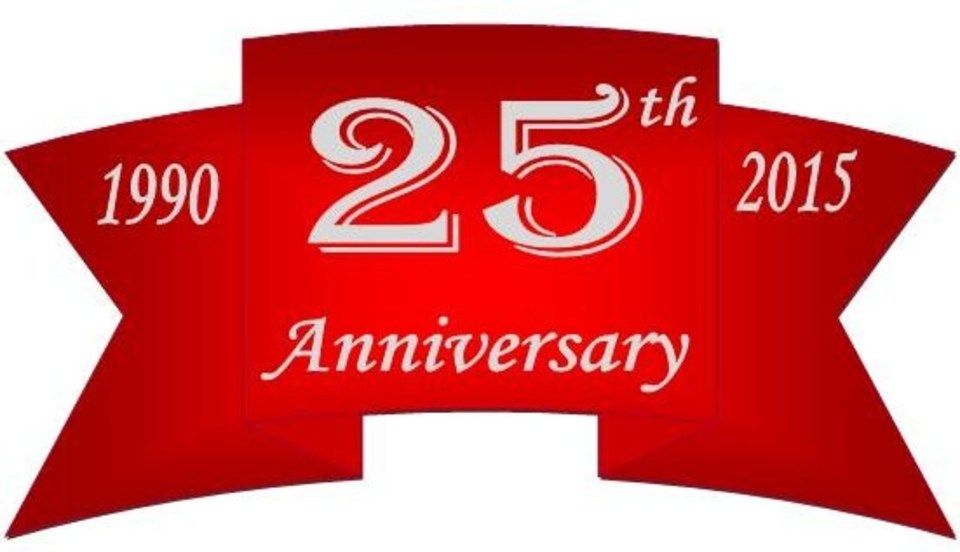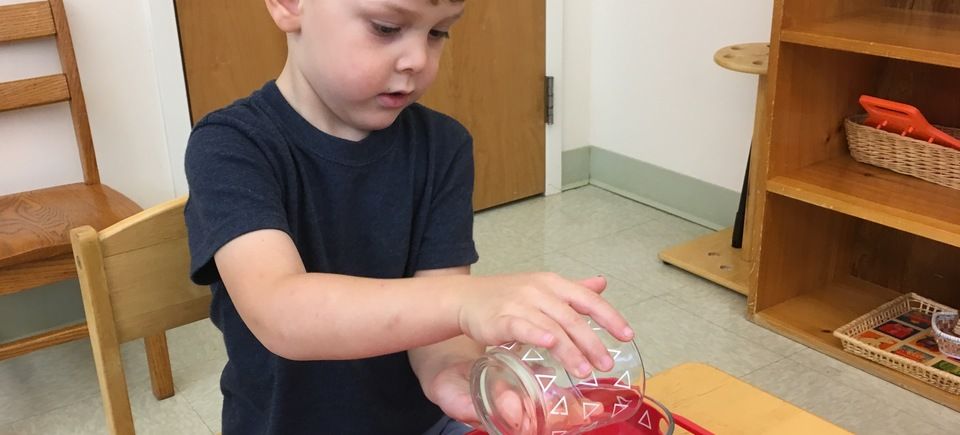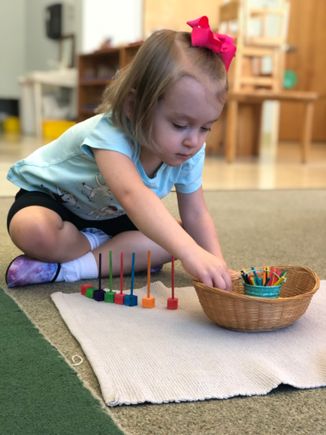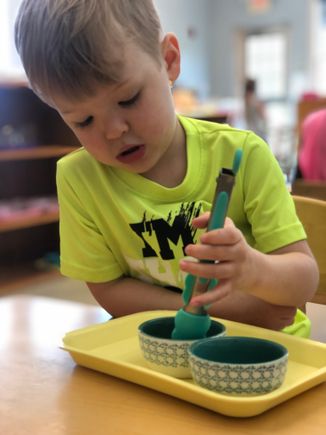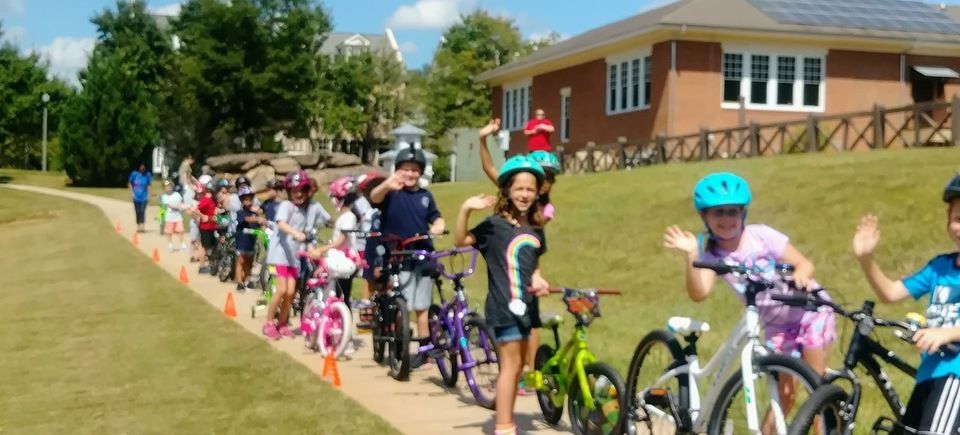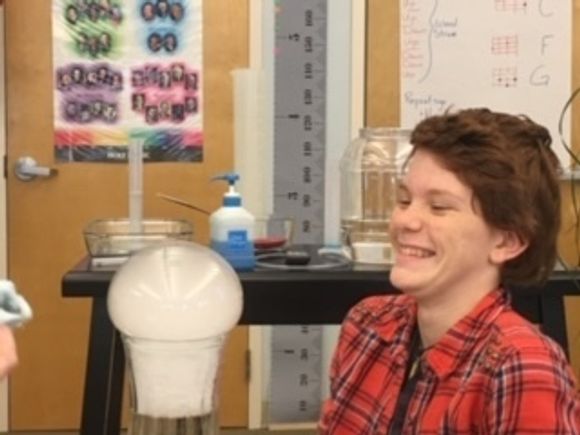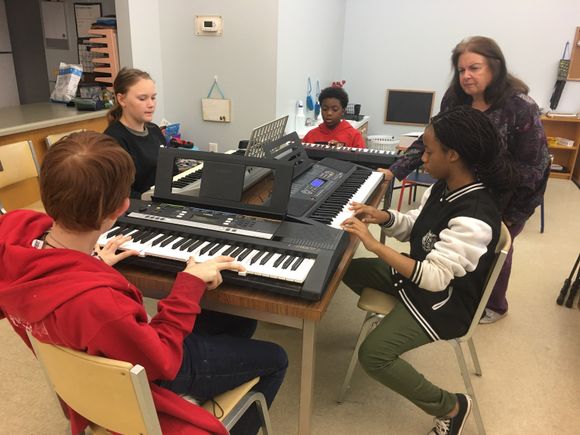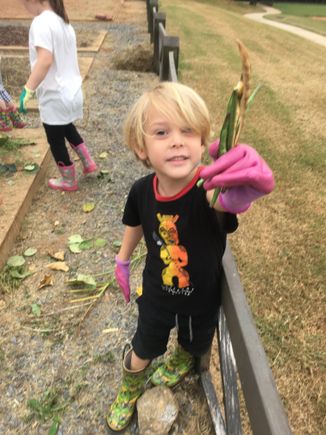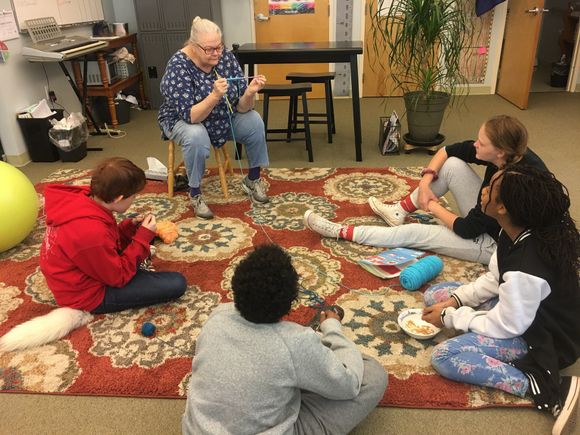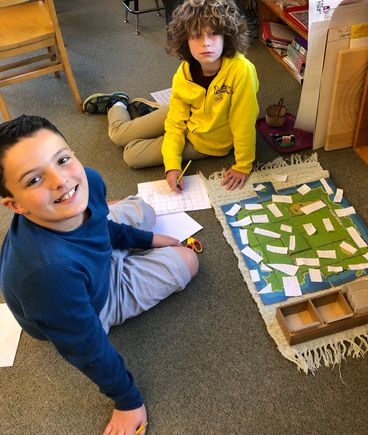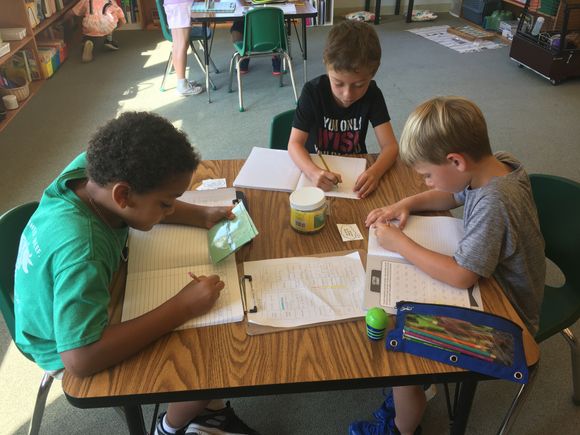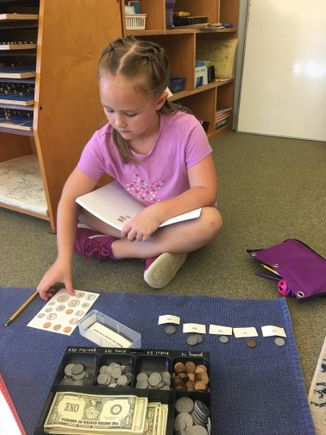Montessori Method
The Montessori classroom seeks to provide each child with a structured environment in which he can freely develop. Structure is important in order to set boundaries, which help the child focus on the task at hand. Freedom is necessary in order for each child to be able to develop at his own pace. And thirdly, action is necessary. It is only through direct manipulation of the environment that significant learning can occur. Through actual experiences with concrete objects the child discovers relationships and concepts which can later be abstracted.
The Montessori materials stimulate a young child's natural desire to learn, guiding him in a series of successful steps to confident, independent study habits.
Practical life activities encourage independence by helping the child to care for himself and his environment, to develop self-control, and to learn consideration for others.
The sensorial materials help the child to clarify and classify differences in the world. These exercises form the base for all future learning experiences.
Sandpaper letter, moveable alphabets, metal insets, and phonics provide the child with keys to the rich and varied world of language.
The knowledge of numbers is based on understanding, not on memory disconnected from actual fact, and provides a basis for later abstract thinking.
Art, music, history, science, and geography are included in the daily activities of the program. Social development takes place naturally within a flexible program geared to the individual rates of progress. With an emphasis on cooperation rather than competition, a spirit of joy and enthusiasm permeates the classroom.
The Montessori classroom seeks to provide each child with a structured environment in which he can freely develop. Structure is important in order to set boundaries, which help the child focus on the task at hand. Freedom is necessary in order for each child to be able to develop at his own pace. And thirdly, action is necessary. It is only through direct manipulation of the environment that significant learning can occur. Through actual experiences with concrete objects the child discovers relationships and concepts which can later be abstracted.
The Montessori materials stimulate a young child's natural desire to learn, guiding him in a series of successful steps to confident, independent study habits.
Practical life activities encourage independence by helping the child to care for himself and his environment, to develop self-control, and to learn consideration for others.
The sensorial materials help the child to clarify and classify differences in the world. These exercises form the base for all future learning experiences.
Sandpaper letter, moveable alphabets, metal insets, and phonics provide the child with keys to the rich and varied world of language.
The knowledge of numbers is based on understanding, not on memory disconnected from actual fact, and provides a basis for later abstract thinking.
Art, music, history, science, and geography are included in the daily activities of the program. Social development takes place naturally within a flexible program geared to the individual rates of progress. With an emphasis on cooperation rather than competition, a spirit of joy and enthusiasm permeates the classroom.
Early Childhood
“…education is a natural process spontaneously carried out by the human individual, and is acquired not by listening to words but by experiences upon the environment.” — Dr. Maria Montessori
The Montessori classroom is referred to as a ‘prepared environment’. This environment encourages children to pursue their interests and to work independently at their own pace. A minimum use of wall displays, soft colors, and child-sized furnishings are the norm in this environment.
A typical day in the Montessori classroom will include activities to encourage independent work, small group activities, demonstrations by the teacher and opportunities to explore the environment both inside and out.
When necessary, teachers assist the child in the decision-making process by offering options from which the child can choose. The Montessori trained teacher is an astute observer who presents appropriate materials to the child or children in small groups. Recording your child’s progress on a daily basis allows the teachers the opportunity to stay in tune to the needs of the child’s and the environment. These records will also assist the teacher in communicating the child’s progress to his/her parents. Teachers in this environment serve as facilitators and observers who offer stimulation and choices. The child’s natural curiosity, love for work, and a sense of community are stimulated and nurtured in this environment.
The Early Childhood Classroom is organized into four major areas: practical life, sensorial, language arts, and mathematics.
Practical life exercises would include buttoning, food preparation, plant care, silver polishing and other activities that encourage self-care, environment care and care for others.
Sensorial area assists in the development of the intellectual skills of classification and mental organization by refining the child’s sense of touch, smell, taste, hearing and sight.
Language arts area develops the many facets of language. Oral language development, creative writing, listening skills, and handwriting development are skill areas that the language area focuses on.
Mathematics area focuses on counting, number recognition, making sets, measuring and patterning.
Arts and music encourages the growth and development of aesthetic qualities. Exercises in science including botany, zoology and physical science along with focus on history, geography and foreign language complete this well rounded curriculum.
The Montessori classroom is referred to as a ‘prepared environment’. This environment encourages children to pursue their interests and to work independently at their own pace. A minimum use of wall displays, soft colors, and child-sized furnishings are the norm in this environment.
A typical day in the Montessori classroom will include activities to encourage independent work, small group activities, demonstrations by the teacher and opportunities to explore the environment both inside and out.
When necessary, teachers assist the child in the decision-making process by offering options from which the child can choose. The Montessori trained teacher is an astute observer who presents appropriate materials to the child or children in small groups. Recording your child’s progress on a daily basis allows the teachers the opportunity to stay in tune to the needs of the child’s and the environment. These records will also assist the teacher in communicating the child’s progress to his/her parents. Teachers in this environment serve as facilitators and observers who offer stimulation and choices. The child’s natural curiosity, love for work, and a sense of community are stimulated and nurtured in this environment.
The Early Childhood Classroom is organized into four major areas: practical life, sensorial, language arts, and mathematics.
Practical life exercises would include buttoning, food preparation, plant care, silver polishing and other activities that encourage self-care, environment care and care for others.
Sensorial area assists in the development of the intellectual skills of classification and mental organization by refining the child’s sense of touch, smell, taste, hearing and sight.
Language arts area develops the many facets of language. Oral language development, creative writing, listening skills, and handwriting development are skill areas that the language area focuses on.
Mathematics area focuses on counting, number recognition, making sets, measuring and patterning.
Arts and music encourages the growth and development of aesthetic qualities. Exercises in science including botany, zoology and physical science along with focus on history, geography and foreign language complete this well rounded curriculum.
Elementary
The Elementary Program expands and extends the structure of the preschool environment, offering individual and small-group instruction using beautiful and dynamic manipulations which present abstract ideas concretely.
Language is an important part of the entire Montessori curriculum for it brings the child to conscious awareness of language and how it can be used more effectively. Once the child has an understanding that writing is a graphic form of language, then he begins work with spelling, word study, penmanship, grammar, punctuation and capitalization. The real experience in reading and writing comes through the child’s work in other areas of the curriculum, such as geography, history, botany, etc.
Foreign Language - Spanish is the foreign language currently being studied in the elementary program.
Mathematics - Manipulation of concrete and symbolic materials with built-in control of error develops sound arithmetic skills and leads the child to make his or her own abstractions. The children work with fraction materials, cubing materials and materials for studying algebra and calculus.
Geometry - Experienced sensorially through manipulation of both plane and solid geometric figures. As much geometric nomenclature is supplied as the child is able to assimilate so that the child will have as much information as possible at his or her command upon entering the stage of exploring why, how and when things happen.
Social Studies and Science (Cultural Studies) - Dr. Maria Montessori felt that social studies and sciences should be integrated in the environment, as they are in life. The subject areas studied include geography, geology, history, botany, zoology, chemistry, sociology and government.
History - The Montessori curriculum follows the development of the solar system, life on Earth, the development of humankind, early civilizations and recorded history. The child sees the long labor of humankind that is needed to accomplish all that is enjoyed here today.
Geography - Studies focus on how the physical configurations of the Earth contribute to our history. The study of physical geography is the basis for the study of economic geography, which shows the interdependence of people.
Art - In the elementary environment, the adult aids the child in the development of skills in order that the child may creatively express him or herself through various media. In addition to art expression, art is an integrating factor for the rest of the curriculum. The child may use it in such ways as geometrical drawings, geographical maps or illustrations for history, botany, zoology, social studies, etc.
Music - The elementary program consists of singing, dancing, music appreciation, guest listening and ear training. There will be opportunities to listen to and discuss many different types of musical instruments.
Physical Education - Biological studies relating to physical education include human anatomy, physiology and nutrition. An interest in the development of skills that could be used in later life is the emphasis, along with the challenge of competing with oneself rather than competing against others.
Language is an important part of the entire Montessori curriculum for it brings the child to conscious awareness of language and how it can be used more effectively. Once the child has an understanding that writing is a graphic form of language, then he begins work with spelling, word study, penmanship, grammar, punctuation and capitalization. The real experience in reading and writing comes through the child’s work in other areas of the curriculum, such as geography, history, botany, etc.
Foreign Language - Spanish is the foreign language currently being studied in the elementary program.
Mathematics - Manipulation of concrete and symbolic materials with built-in control of error develops sound arithmetic skills and leads the child to make his or her own abstractions. The children work with fraction materials, cubing materials and materials for studying algebra and calculus.
Geometry - Experienced sensorially through manipulation of both plane and solid geometric figures. As much geometric nomenclature is supplied as the child is able to assimilate so that the child will have as much information as possible at his or her command upon entering the stage of exploring why, how and when things happen.
Social Studies and Science (Cultural Studies) - Dr. Maria Montessori felt that social studies and sciences should be integrated in the environment, as they are in life. The subject areas studied include geography, geology, history, botany, zoology, chemistry, sociology and government.
History - The Montessori curriculum follows the development of the solar system, life on Earth, the development of humankind, early civilizations and recorded history. The child sees the long labor of humankind that is needed to accomplish all that is enjoyed here today.
Geography - Studies focus on how the physical configurations of the Earth contribute to our history. The study of physical geography is the basis for the study of economic geography, which shows the interdependence of people.
Art - In the elementary environment, the adult aids the child in the development of skills in order that the child may creatively express him or herself through various media. In addition to art expression, art is an integrating factor for the rest of the curriculum. The child may use it in such ways as geometrical drawings, geographical maps or illustrations for history, botany, zoology, social studies, etc.
Music - The elementary program consists of singing, dancing, music appreciation, guest listening and ear training. There will be opportunities to listen to and discuss many different types of musical instruments.
Physical Education - Biological studies relating to physical education include human anatomy, physiology and nutrition. An interest in the development of skills that could be used in later life is the emphasis, along with the challenge of competing with oneself rather than competing against others.
Middle School
- 21st century skills of communication, collaboration, planning, and other non-cognitive skills that current brain research now proves are key to long-term academic and life successes.
- A challenging curriculum that follows the developmentally proven needs of adolescents and state-standards in math, language science, history, and government.
- Small class sizes, so teachers can know and give individualized instruction to students.
- Project-based learning where individuals or small groups can learn by doing-- developing their own hands-on, cross-curriculum projects, organizing and planning its completion, learning and analyzing the outcomes using critical thinking and analysis.
- Real & relevant experiences, like internships in the workplace & class-managed business enterprises, are developmentally essential to adolescents as they strive to understand their role and influence on the world.
- The Arts, opportunities for creative expressions in frequent music and art classes, are valued.
- Physical activity throughout the day, because movement is important to growing bodies, developing motor skills, and a means of improving mental focus.
- Community-building and conflict resolution take place of peer conflicts and unhealthy cliques.
- Life skills that were once in schools, but gradually replaced with high-stakes testing have a place here. Personal finance, simple carpentry and engineering challenges, cooking, sewing, and gardening promote confidence, collaboration, and independence. (As a testament to our commitment, we have a kitchen in the classroom!)
- Field trips (at least monthly) to museums, historical sites, technology centers, and natural environments including unique kayaking and camping make classroom lessons come to life and provide adventures that this age thrives on.
- Opportunities for service learning, putting young people in touch with community leaders, business people, and involved citizens—empowering them to make a difference. Recognizing one’s ability to help others is a strong motivation for personal growth and building block for self-confidence.
- Experiences in nature, because the next generation can only be prepared to make their world better if they are at home in the world. Research has proven that nature improves mental and emotional health.
- Degreed, certified and experienced Montessori educators who develop experiences to meet the needs of students.

